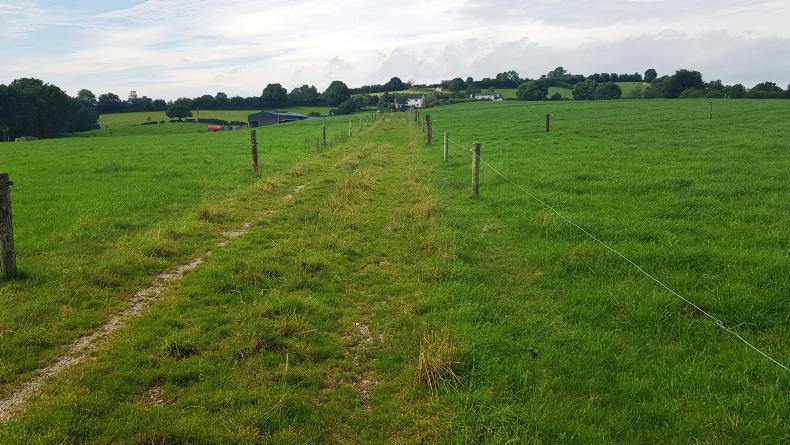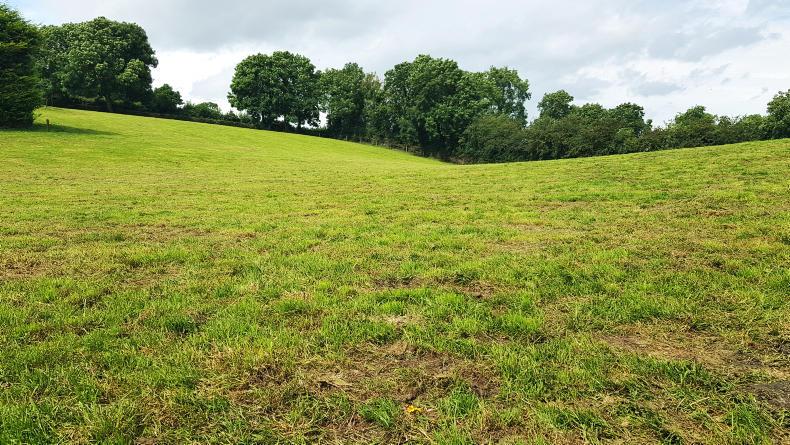Frank Goodman has been topping paddocks after cows if post-grazing residuals are high to maintain sward quality on his farm near Carrickmacross, Co Monaghan. A mower is used for topping, which cleans paddocks off at around 2in to remove any stemmy material that is growing.
However, efforts to maintain grass quality can sometimes appear to be in vain. Like other Dairylink participants, Frank notices that butterfat levels have dropped when cows are put into leafy swards and have risen when paddocks with a higher stem content are being grazed.
He said that butterfat levels usually take a dip in June, but have dropped back again in recent weeks from 3.83% to 3.61%. He still wants to maintain sward quality to keep milk volumes up while minimising concentrate feeding.
A grass sample from a paddock that was due to be grazed last week was sent for analysis, but the results did not show anything that would affect butterfat. Most measures were close to the July average. For example, metabolisable energy was 11.0MJ/kg DM, acid detergent fibre was 23.8% and dry matter was 17.8%.

Frank has well-developed grazing infrastructure on his milking platform.
The composition of the parlour nut has been revised to help lift milk components. The main change was to increase the amount of digestible fibre by reducing cereal content and increasing the proportion of sugar beet pulp to 15%. Butterfat levels have since moved up to 3.70%.
Dairylink Ireland adviser Aidan Cushnahan points out that other feed ingredients which can act as sources of digestible fibre include citrus pulp and soya hulls.
Grass analysis showed that crude protein levels were high at 23.8%, which compares with the July average of 17.4%. Aidan said that this indicates that the protein content of the parlour nut does not need to increase yet from the current level of 14%. Frank’s cows are currently getting 2kg/cow/day of concentrates.
Weekly round-up
Thoughts are turning to building covers on Dairylink Ireland farms from mid-August to allow extended grazing into the autumn.Programme farmers with autumn-calving cows are continuing to dry off cows and preparations are also being made for calving.Farmers are being encouraged to use the quieter time to review farm finances and develop cashflow budgets for the 2019/20 season.Some Dairylink participants have been making third-cut silage this week.Silage, reseeding and drying off
Second-cut silage was ensiled on 20 July on the Goodman farm. There was no slurry spread on silage ground after first cut, so second cut should be low in potash and will be suitable for spring-calving dry cows to help avoid cases of milk fever.
Second cut was later than planned, as samples of grass that were sent for analysis after six and seven weeks showed that nitrate concentrations remained high. The silage ground received 100 units/acre of nitrogen and was growing for eight weeks. Although growth rates were relatively high over the period, the grass used the nitrogen at a standard rate of around two units/acre/day.

There is 22.5ha available for a milking platform on the Goodman farm.
The crop bulked well and Frank has made significant progress in filling silage reserves for the 2019/20 winter. There will be a third cut and strong growth rates have allowed surplus grass to be baled off the milking platform this year.
This is the first year that Frank has used protected urea for nitrogen fertiliser applications. The entire milking platform gets a blanket treatment of 35 units/acre once a month. There have been no applications of CAN or unprotected urea this year.
Protected urea has the same nitrogen recovery efficiency as CAN and, although more expensive than CAN on a per-tonne basis, it has a higher nitrogen content (46% vs 27%) so is more economical per kilo of nitrogen.
Drying off
Frank runs a 90-cow Holstein herd, with 80% calving in the spring and the rest in an autumn-calving group.
Selective dry cow therapy was used on the farm for the first time last winter when the spring calvers were being dried off. Frank was happy with the results and is carrying it out again for the autumn calvers this summer.
There were eight autumn calvers dried off last week. The selective dry cow therapy protocol for Frank’s farm is cows with a somatic cell count of under 150,000/ml in all milk recordings and no cases of mastitis over the past lactation get treated with a teat sealer only.
The last field was sprayed with glyphosate before first-cut silage and was drilled with an air seeder afterwards at 19kg/acre
Min till is used for most reseeding on the Goodman farm, with 20 acres reseeded so far this year. The last field was sprayed with glyphosate before first-cut silage and was drilled with an air seeder afterwards at 19kg/acre.
Frank said that the reseed struck well and this year’s calves are grazing it at present, with no concentrates being offered.
Spring 2018-born heifers were in the yard in late July for a lungworm dose and Frank used the opportunity to run them over the electronic scales to review weight gains.
This batch averaged 430kg at 16.5 months, which equates to a daily liveweight gain of 0.78kg from birth.
These heifers were artificially inseminated on standing heats for six weeks and now have a sweeper bull running with them.
Read more
Managing cows indoors in Co Armagh
Reviewing replacement heifers in Down
Frank Goodman has been topping paddocks after cows if post-grazing residuals are high to maintain sward quality on his farm near Carrickmacross, Co Monaghan. A mower is used for topping, which cleans paddocks off at around 2in to remove any stemmy material that is growing.
However, efforts to maintain grass quality can sometimes appear to be in vain. Like other Dairylink participants, Frank notices that butterfat levels have dropped when cows are put into leafy swards and have risen when paddocks with a higher stem content are being grazed.
He said that butterfat levels usually take a dip in June, but have dropped back again in recent weeks from 3.83% to 3.61%. He still wants to maintain sward quality to keep milk volumes up while minimising concentrate feeding.
A grass sample from a paddock that was due to be grazed last week was sent for analysis, but the results did not show anything that would affect butterfat. Most measures were close to the July average. For example, metabolisable energy was 11.0MJ/kg DM, acid detergent fibre was 23.8% and dry matter was 17.8%.

Frank has well-developed grazing infrastructure on his milking platform.
The composition of the parlour nut has been revised to help lift milk components. The main change was to increase the amount of digestible fibre by reducing cereal content and increasing the proportion of sugar beet pulp to 15%. Butterfat levels have since moved up to 3.70%.
Dairylink Ireland adviser Aidan Cushnahan points out that other feed ingredients which can act as sources of digestible fibre include citrus pulp and soya hulls.
Grass analysis showed that crude protein levels were high at 23.8%, which compares with the July average of 17.4%. Aidan said that this indicates that the protein content of the parlour nut does not need to increase yet from the current level of 14%. Frank’s cows are currently getting 2kg/cow/day of concentrates.
Weekly round-up
Thoughts are turning to building covers on Dairylink Ireland farms from mid-August to allow extended grazing into the autumn.Programme farmers with autumn-calving cows are continuing to dry off cows and preparations are also being made for calving.Farmers are being encouraged to use the quieter time to review farm finances and develop cashflow budgets for the 2019/20 season.Some Dairylink participants have been making third-cut silage this week.Silage, reseeding and drying off
Second-cut silage was ensiled on 20 July on the Goodman farm. There was no slurry spread on silage ground after first cut, so second cut should be low in potash and will be suitable for spring-calving dry cows to help avoid cases of milk fever.
Second cut was later than planned, as samples of grass that were sent for analysis after six and seven weeks showed that nitrate concentrations remained high. The silage ground received 100 units/acre of nitrogen and was growing for eight weeks. Although growth rates were relatively high over the period, the grass used the nitrogen at a standard rate of around two units/acre/day.

There is 22.5ha available for a milking platform on the Goodman farm.
The crop bulked well and Frank has made significant progress in filling silage reserves for the 2019/20 winter. There will be a third cut and strong growth rates have allowed surplus grass to be baled off the milking platform this year.
This is the first year that Frank has used protected urea for nitrogen fertiliser applications. The entire milking platform gets a blanket treatment of 35 units/acre once a month. There have been no applications of CAN or unprotected urea this year.
Protected urea has the same nitrogen recovery efficiency as CAN and, although more expensive than CAN on a per-tonne basis, it has a higher nitrogen content (46% vs 27%) so is more economical per kilo of nitrogen.
Drying off
Frank runs a 90-cow Holstein herd, with 80% calving in the spring and the rest in an autumn-calving group.
Selective dry cow therapy was used on the farm for the first time last winter when the spring calvers were being dried off. Frank was happy with the results and is carrying it out again for the autumn calvers this summer.
There were eight autumn calvers dried off last week. The selective dry cow therapy protocol for Frank’s farm is cows with a somatic cell count of under 150,000/ml in all milk recordings and no cases of mastitis over the past lactation get treated with a teat sealer only.
The last field was sprayed with glyphosate before first-cut silage and was drilled with an air seeder afterwards at 19kg/acre
Min till is used for most reseeding on the Goodman farm, with 20 acres reseeded so far this year. The last field was sprayed with glyphosate before first-cut silage and was drilled with an air seeder afterwards at 19kg/acre.
Frank said that the reseed struck well and this year’s calves are grazing it at present, with no concentrates being offered.
Spring 2018-born heifers were in the yard in late July for a lungworm dose and Frank used the opportunity to run them over the electronic scales to review weight gains.
This batch averaged 430kg at 16.5 months, which equates to a daily liveweight gain of 0.78kg from birth.
These heifers were artificially inseminated on standing heats for six weeks and now have a sweeper bull running with them.
Read more
Managing cows indoors in Co Armagh
Reviewing replacement heifers in Down








 This is a subscriber-only article
This is a subscriber-only article









SHARING OPTIONS: